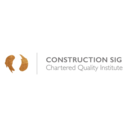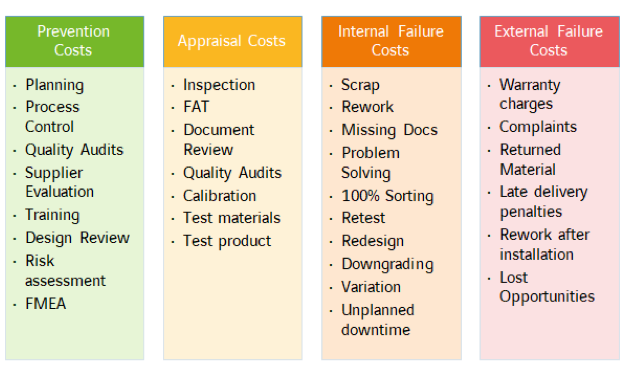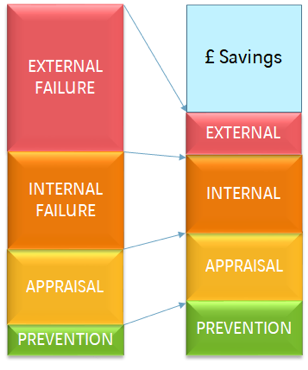Cost of quality (COQ)
Contents |
[edit] What is cost of quality (COQ)?
More accurately the question should be `What is the cost of poor quality?` or even `What is the cost of not getting it right first time?`. The principle of COQ is quite simple as it is often described by using the PAF(F) model (see below), ie the total cost of getting it right plus the additional costs of getting it wrong. The three main areas of the PAF model are:
- Failure: costs of defects whether we see them internally (eg cost of any reject products we make that we find ourselves) or externally (eg rejects that we have missed but has ended up with the customer)
- Appraisal: cost of measuring or monitoring (eg inspection of the product, auditing the process to make sure the system performs correctly)
- Prevention: cost of preventing defects (eg designing or planning to make it difficult to create defects); note: this is a positive cost which if implemented correctly will reduce the failure-cost reducing the total COQ.
Note: this is a very generic and simplified explanation of the costs required to be measured but it is important to get a visualisation of the process.
Measuring these costs is not so easy to do and requires a lot of effort but the benefits are considerable as this is the language of money - the language that the boardroom understands!
[edit] History of COQ
Dr Joseph Juran (one of the eminent quality management Gurus) introduced the concept of COQ in his `Quality Control Handbook` in the 1950s which has been developed over the years and was incorporated in the US MIL standards (Department of Defence) in 1963. Dr Armand Feigenbaum introduced the concept of the `hidden plant` in his book `Total Quality Control` in 1951 quoting a figure of 40% of the plant is wasted by not getting it right first time. The American Society for Quality (ASQ) published `Quality Costs - What and How` in 1967 and over the years ASQ has become the recognised authority for the use of quality cost systems.
[edit] PAF(F) model
The PAF(F) model stands for prevention, appraisal & failure (internal & external - hence the extra `F`) which are the main elements of breaking down COQ. Figure 1 attempts to identify some of the potential costs and categorises them in the PAF(F) model.
Figure 1 - Examples of PAF(F) costs
- Prevention costs are activities that are designed to prevent poor quality from arising in products (and services) so as you can imagine often these costs are realised early in the lifecycle of a project. These can include elements of risk management (FMEA, risk assessments, internal audits etc), planning activities, design (designing to reduce the potential for failure), supplier evaluation, ensuring suppliers have the capabilities to carry out the tasks and even internal audits used to identify concerns ready for mitigation before the process starts.
- Appraisal costs are activities that will be put in place to check or control the products and services, such as inspection, testing and internal audits (checking that processes and systems are still working), verifying and validating.
- Internal failure costs are caused by products (or services) not conforming to requirements before the customer receives delivery. Any process which does not achieve `right first time` can be deemed an internal failure cost such as the requirement to re-design, products that are scrapped or re-worked, downtime for machinery etc.
- External Failure costs are caused by issues caused internally that end up with external customer. These can include the cost of rework, replacement, time spent on customer complaints, reputation costs etc.
[edit] Benefits
The real aim of measuring these costs whether at project or business level is that you can identify what the main costs are and to determine opportunities for improvement. Figure 2 shows the model as to how the PAF(F) elements make up the total cost of quality, and that more is spent on failure costs than on prevention & appraisal.
Figure 2 – Model of current and future costs
CURRENT COSTS ------------------- FUTURE COSTS
Ideally the business wants to be able to spend more money on prevention to reduce the level of failure costs which will ultimately mean cost savings. This is a great opportunity for the quality team to `add value` to the business.
[edit] Practical Tips
- Measuring COQ for the whole business is not for the faint-hearted as determining all the costs requires input from many departments in the business
- Measuring COQ within a project is slightly easier but will need the whole team to be bought into the concept. Ideally the costs to measure will need to be identified before the project has started
- Don`t try to measure everything but choose costs which are likely to have an impact, but it is hugely important to measure the costs in a consistent way; eg measuring the cost of customer complaints using the same method at regular intervals
- Concentrate on measuring specific repeatable activities rather than `one-off` failures as these will generate long term savings that will last forever.
[edit] Useful Links
- https://asq.org/quality-resources/cost-of-quality - a couple of good videos on this page
- https://www.isixsigma.com/implementation/financial-analysis/cost-quality-not-only-failure-costs/
This article was originally written by Alan Grogan on behalf of the CQI Construction Special Interest Group, reviewed by Luca Fiderio and members of the Competency Working Group and approved for publication by the Steering Committee on 23 November 2019.
--ConSIG CWG 12:56, 15 Jan 2020 (BST)
[edit] Related articles on Designing Buildings Wiki
- CDM Regulations: a quality perspective
- Change control: a quality perspective
- Collaboration: a quality management perspective
- Design freeze: a quality perspective
- Design: a quality management perspective
- Digital quality management in construction
- Lifts and Escalators: A Quality Perspective
- Mobilisation to site: a quality perspective
- Quality culture and behaviours
- Quality manuals and quality plans
- Quality tools: fishbone diagram
- Stakeholder management: a quality perspective
- Structural steelwork: a quality perspective
Featured articles and news
The UK's Modern Industrial Strategy: A 10 year plan
Previous consultation criticism, current key elements and general support with some persisting reservations.
Building Safety Regulator reforms
New roles, new staff and a new fast track service pave the way for a single construction regulator.
Architectural Technologist CPDs and Communications
CIAT CPD… and how you can do it!
Cooling centres and cool spaces
Managing extreme heat in cities by directing the public to places for heat stress relief and water sources.
Winter gardens: A brief history and warm variations
Extending the season with glass in different forms and terms.
Restoring Great Yarmouth's Winter Gardens
Transforming one of the least sustainable constructions imaginable.
Construction Skills Mission Board launch sector drive
Newly formed government and industry collaboration set strategy for recruiting an additional 100,000 construction workers a year.
New Architects Code comes into effect in September 2025
ARB Architects Code of Conduct and Practice available with ongoing consultation regarding guidance.
Welsh Skills Body (Medr) launches ambitious plan
The new skills body brings together funding and regulation of tertiary education and research for the devolved nation.
Paul Gandy FCIOB announced as next CIOB President
Former Tilbury Douglas CEO takes helm.
UK Infrastructure: A 10 Year Strategy. In brief with reactions
With the National Infrastructure and Service Transformation Authority (NISTA).
Ebenezer Howard: inventor of the garden city. Book review.
The Grenfell Tower fire, eight years on
A time to pause and reflect as Dubai tower block fire reported just before anniversary.
Airtightness Topic Guide BSRIA TG 27/2025
Explaining the basics of airtightness, what it is, why it's important, when it's required and how it's carried out.
Construction contract awards hit lowest point of 2025
Plummeting for second consecutive month, intensifying concerns for housing and infrastructure goals.
Understanding Mental Health in the Built Environment 2025
Examining the state of mental health in construction, shedding light on levels of stress, anxiety and depression.
The benefits of engaging with insulation manufacturers
When considering ground floor constructions.
Lighting Industry endorses Blueprint for Electrification
The Lighting Industry Association fully supports the ECA Blueprint as a timely, urgent call to action.



























Comments
I would also recommend the book Quality is Free by Philip Crosby.